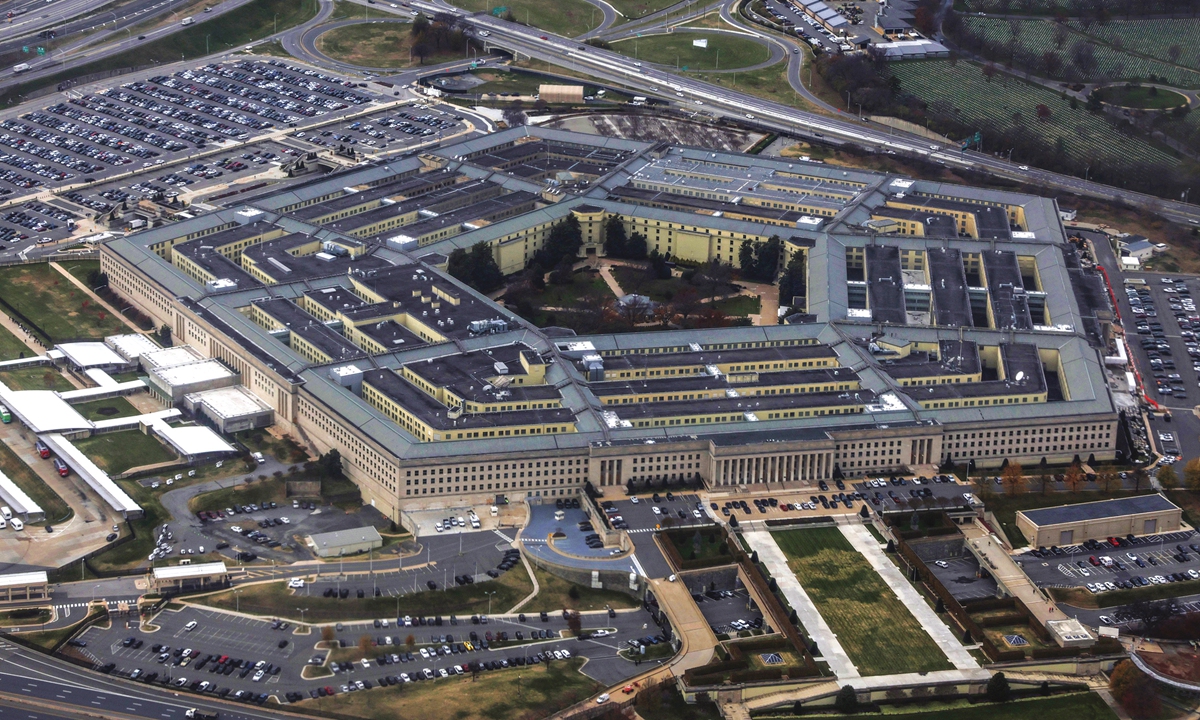Scare tactics about China seem more about securing tax dollars for US military spending

The Pentagon Photos: VCG
There is a saying about American journalism, and it is attributed to a one-time, small-city newspaper editor: "Whatever a patron wants published is advertising. Whatever he wants to keep out of the paper is news!"
That phrase should have echoed through the minds of American news consumers when they read a story a few days ago on a pro-military website that claims to offer "deeper insights to a highly loyal audience comprised of technology enthusiasts, defense insiders, and decision-makers, as well as active-duty military members." The story began with this headline: "Alarming Navy Intel Slide Warns Of China's 200 Times Greater Shipbuilding Capacity."
Readers were soon told that the single slide outlined "the worrisome disparity between Chinese and US capacity to build new naval vessels and total naval force sizes." Deeper in the story readers were informed that "there is clearly a major and widening gap in battle force sizes between China and the United States."
One day later, the story was amplified once it was summarized by a conservative website. That article reminded readers that the Secretary of the Navy had acknowledged in Congressional testimony earlier this year that one Chinese shipyard "has more capacity [to build warships] than all of our shipyards combined."
It seems reasonable to presume the person (or people) responsible for leaking the slide had a clear purpose in mind: Promote the idea that the US Navy remains underfunded and therefore would be under threat should it engage in any future battle with its Chinese counterpart. In other words, and using the words of that aforementioned editor, the person (or people) wanted to advertise the idea that the Navy was underappreciated and deserved to be treated better.
Of course, neither story called attention to the excessive overall US military budget, which offers a much different assessment of what America's forces can do. The respected Stockholm International Peace Research Institute reported that in 2022 the US allocated almost $877 billion to defending the homeland (oh, and carrying on aggressive military actions across the globe). That figure becomes even more eye-opening when you realize that America accounts for almost 39 percent of the world's defense outlay. The next 14 countries? Roughly 36 percent combined.
In case you are wondering, the 2022 US budget allocated $211.7 billion to the Navy. In comparison, the Army received a paltry $173 billion and the Air Force received a measly $156 billion. Granted, the most complex warships are not cheap - one American aircraft carrier came with a $13 billion price tag just four years ago - but the Navy Times, which will never be accused of harboring ill will toward the entire US defense industry, stated a couple of years ago that when compared to China, the US Navy "has vastly more experience with global maritime operations." A scholar at the Naval War College added that it was "superficial" to use simple math - how many ships each side has, how many men and women are in uniform and the like - in assessing the capabilities of the US and Chinese navies.
The military-industrial complex must be consistently fed, and that cannot happen unless Americans are reminded day after day that China (or Russia, or Iran, or North Korea, or fill in the blank country) remain an existential threat to the US and the Western-created global order. The bitter truth is that the US war machine is sufficiently stocked to fight any war in any location, although the quagmires that were Iraq and Afghanistan from earlier this century should make Americans ask exactly what kind of military does $877 billion actually buy.
Meanwhile, the conversation about China in Washington and throughout America is out of control, even the Chairman of the Joint Chiefs has said that must change. In an interview earlier this year, Gen. Mark Milley said the "rhetoric itself can overheat the environment." Later, he added, "I don't believe war [between the US and China] is inevitable. I don't think it's imminent. But I do think that we need to be very, very pragmatic and cautious going forward."
Square those words with one slide about China and its capabilities to build warships and perhaps the message should be: That slide is the equivalent of one data point in a complex assessment of the navies of both the US and China. Once that reality becomes clear, then another message needs to be offered: The fear that China will overpower the US Navy on the high seas seems all about securing more and more tax dollars.
As one respected news magazine told its readers just two weeks ago, "we must ensure that panic and fear do not drive US foreign policy as it had during the Cold War or the war on terror."
Words to remember.
The author is an associate professor at the Department of Communication and Organizational Leadership at Pittsburgh-based Robert Morris University. opinion@globaltimes.com.cn

